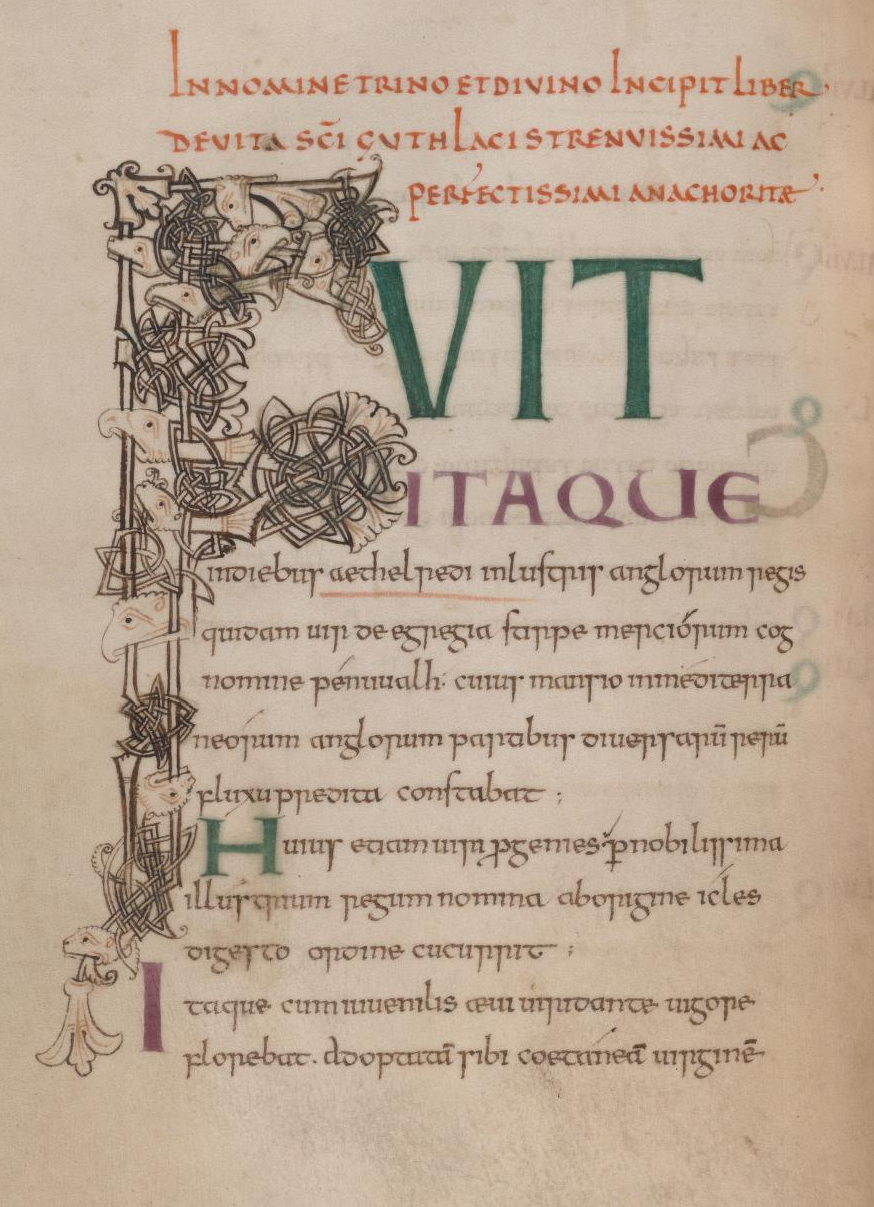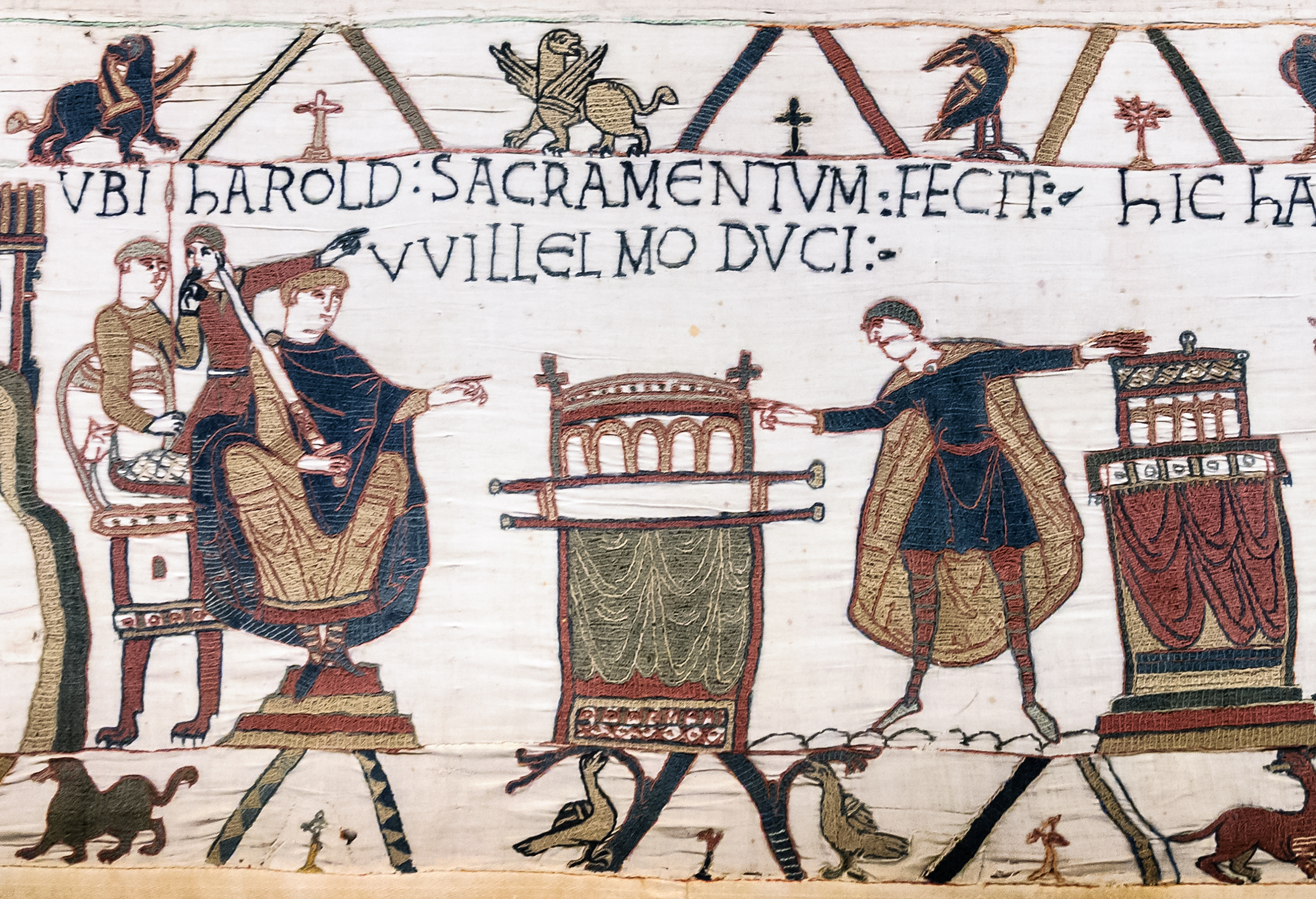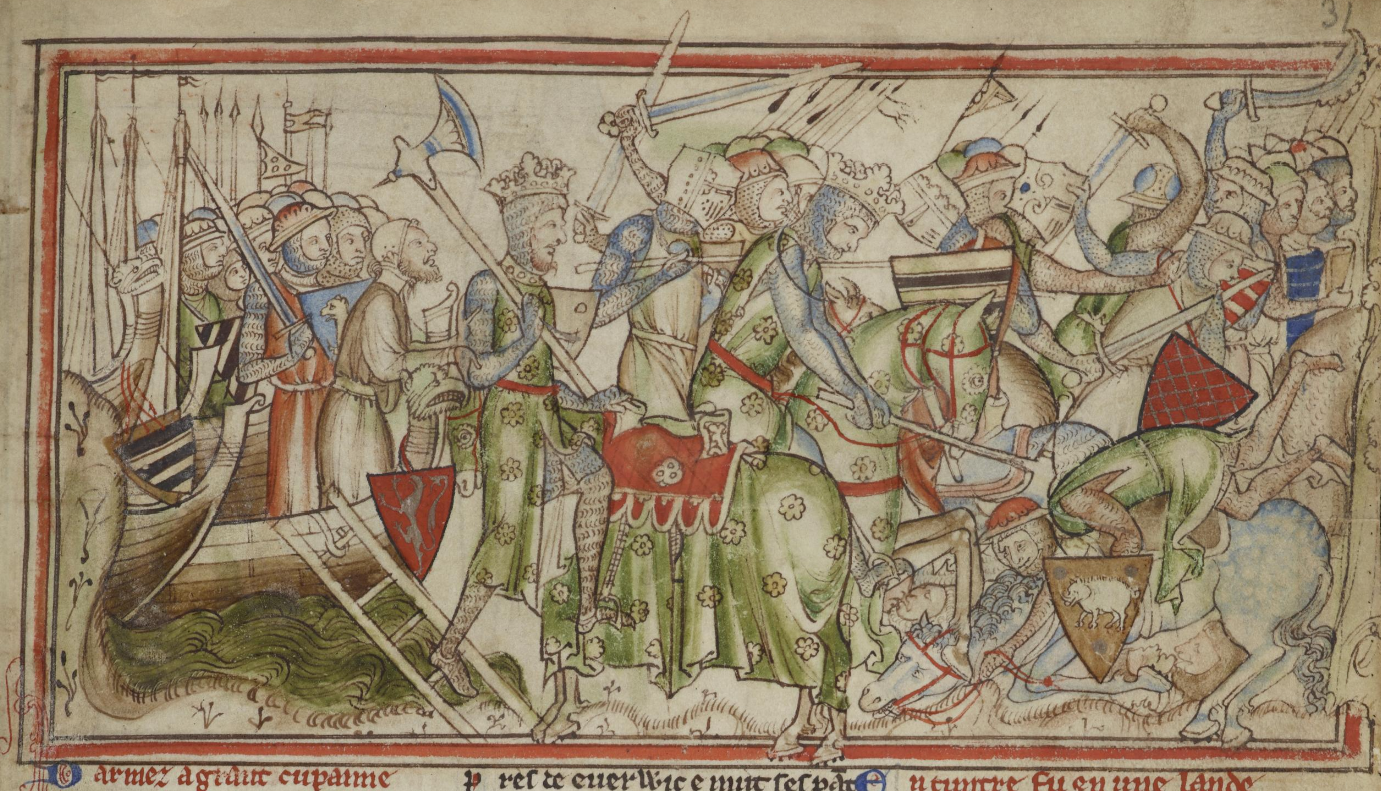|
Г†lfgar, Earl Of Mercia
Ælfgar (died ) was the son of Leofric, Earl of Mercia, by his famous wife Godgifu ( Lady Godiva). He succeeded to his father's title, Earl of Mercia, and responsibilities on the latter's death in 1057. He gained the additional title of Earl of East Anglia, but also was exiled for a time. Through the first marriage of his daughter he became father-in-law to Welsh king Gruffydd ap Llywelyn. A few years after Ælfgar's death, his daughter became a widow and married Harold Godwinson, the last king of Anglo-Saxon England. War and exile Ælfgar profited from the exile of Earl Godwin of Wessex and his sons in 1051. He was given the Earldom of East Anglia, which had been that of Harold, son of Godwin. Earl Godwin and King Edward were reconciled the following year, so Harold was restored to his earldom—but not for long. At Easter 1053 Godwin died, so Harold became Earl of Wessex, and the earldom of East Anglia returned to Ælfgar.Ann Williams, 'Ælfgar, earl of Mercia (d. 1060)’ ... [...More Info...] [...Related Items...] OR: [Wikipedia] [Google] [Baidu] |
Guthlac Roll - The Benefactors
Saint Guthlac of Crowland (; ; 674714AD) was a Christian hermit and saint from Lincolnshire in England. He is particularly venerated in the Fens of eastern England. Hagiography Early life Guthlac was the son of Penwalh or Penwald, a noble of the English kingdom of Mercia, and his wife Tette. Guthlac's sister is venerated as St Pega. As a young man, Guthlac fought in the army of King Г†thelred of Mercia (). He subsequently became a monk at Repton Abbey in Derbyshire at the age of 24, under the abbess there (Repton being a double monastery). Two years later he sought to live the life of a hermit, and moved out to the island of Croyland, now called Crowland (in present-day Lincolnshire), on St Bartholomew's Day, 699. His early biographer, Felix, writing in the early 8th century, asserts that Guthlac could understand the ('sibilant speech', that is "barbarous language") of Brittonic-speaking demons who haunted him there, only because Guthlac had spent some time in exile a ... [...More Info...] [...Related Items...] OR: [Wikipedia] [Google] [Baidu] |
William Malet (companion Of William The Conqueror)
William Malet ( Anglo-Norman: Willame Malet de Graville, died 1071) held senior positions within the Norman forces that occupied England from 1066. He was appointed the second High Sheriff of Yorkshire in 1068. Of the so-called companions of William of Normandy, Malet is one of about a dozen for whom there is evidence of their presence at the Battle of Hastings of 14 October 1066. For example, the contemporary chronicler William of Poitiers recorded that Malet was present at the battle. According to apocryphal accounts, Malet was related to both William of Normandy and King Harold of England. Some accounts claim that Malet took charge of Harold's body following the Norman victory at Hastings. However, there is no evidence confirming such a claim. Malet held substantial property in Normandy – chiefly in the Pays de Caux, with a castle at (now a suburb of Le Havre). After 1066, he held many properties in England as well, most of them in East Anglia, centered on the Hono ... [...More Info...] [...Related Items...] OR: [Wikipedia] [Google] [Baidu] |
Shropshire
Shropshire (; abbreviated SalopAlso used officially as the name of the county from 1974–1980. The demonym for inhabitants of the county "Salopian" derives from this name.) is a Ceremonial counties of England, ceremonial county in the West Midlands (region), West Midlands of England, on the England–Wales border, border with Wales. It is bordered by Cheshire to the north-east, Staffordshire to the east, Worcestershire to the south-east, Herefordshire to the south, and the Welsh principal areas of Powys and Wrexham County Borough, Wrexham to the west and north-west respectively. The largest settlement is Telford, while Shrewsbury is the county town. The county has an area of and a population of 498,073. Telford in the east and Shrewsbury in the centre are the largest towns. Shropshire is otherwise rural, and contains market towns such as Oswestry in the north-west, Market Drayton in the north-east, Bridgnorth in the south-east, and Ludlow in the south. For Local government i ... [...More Info...] [...Related Items...] OR: [Wikipedia] [Google] [Baidu] |
Staffordshire
Staffordshire (; postal abbreviation ''Staffs''.) is a Ceremonial counties of England, ceremonial county in the West Midlands (region), West Midlands of England. It borders Cheshire to the north-west, Derbyshire and Leicestershire to the east, Warwickshire to the south-east, the West Midlands (county), West Midlands county and Worcestershire to the south, and Shropshire to the west. The largest settlement is the city of Stoke-on-Trent. The county has an area of and a population of 1,131,052. Stoke-on-Trent is located in the north and is immediately adjacent to the town of Newcastle-under-Lyme. Stafford is in the centre of the county, Burton upon Trent in the east, and the city of Lichfield and Tamworth, Staffordshire, Tamworth in the south-east. For local government purposes Staffordshire comprises a non-metropolitan county, with nine districts, and the Unitary authorities of England, unitary authority area of Stoke-on-Trent. The county Historic counties of England, historical ... [...More Info...] [...Related Items...] OR: [Wikipedia] [Google] [Baidu] |
Reims
Reims ( ; ; also spelled Rheims in English) is the most populous city in the French Departments of France, department of Marne (department), Marne, and the List of communes in France with over 20,000 inhabitants, 12th most populous city in France. The city lies northeast of Paris on the Vesle river, a tributary of the Aisne (river), Aisne. Founded by the Gauls, Reims became a major city in the Roman Empire. Reims later played a prominent ceremonial role in history of France, French monarchical history as the traditional site of the coronation of the kings of France. The royal anointing was performed at the Cathedral of Reims, which housed the Holy Ampulla of chrism allegedly brought by a white dove at the baptism of Frankish king Clovis I in 496. For this reason, Reims is often referred to in French as ("the Coronation City"). Reims is recognized for the diversity of its heritage, ranging from Romanesque architecture, Romanesque to Art Deco, Art-dГ©co. Reims Cathedral, the ad ... [...More Info...] [...Related Items...] OR: [Wikipedia] [Google] [Baidu] |
Rome
Rome (Italian language, Italian and , ) is the capital city and most populated (municipality) of Italy. It is also the administrative centre of the Lazio Regions of Italy, region and of the Metropolitan City of Rome. A special named with 2,746,984 residents in , Rome is the list of cities in the European Union by population within city limits, third most populous city in the European Union by population within city limits. The Metropolitan City of Rome Capital, with a population of 4,223,885 residents, is the most populous metropolitan cities of Italy, metropolitan city in Italy. Rome metropolitan area, Its metropolitan area is the third-most populous within Italy. Rome is located in the central-western portion of the Italian Peninsula, within Lazio (Latium), along the shores of the Tiber Valley. Vatican City (the smallest country in the world and headquarters of the worldwide Catholic Church under the governance of the Holy See) is an independent country inside the city boun ... [...More Info...] [...Related Items...] OR: [Wikipedia] [Google] [Baidu] |
Harold II
Harold Godwinson ( – 14 October 1066), also called Harold II, was the last crowned Anglo-Saxon King of England. Harold reigned from 6 January 1066 until his death at the Battle of Hastings on 14 October 1066, the decisive battle of the Norman Conquest. He was succeeded by William the Conqueror, the victor at Hastings. Harold Godwinson was a member of the most powerful noble family in England, his father Godwin having been made Earl of Wessex by Cnut the Great. Harold, who served previously as Earl of East Anglia, was appointed to his father's earldom on Godwin's death. After his brother-in-law, King Edward the Confessor, died without an heir on 5 January 1066, the ''Witenagemot'' convened and chose Harold to succeed him; he was probably the first English monarch to be crowned in Westminster Abbey. In late September, he defeated an invasion by rival claimant Harald Hardrada of Norway in the Battle of Stamford Bridge near York before marching his army back south to meet William ... [...More Info...] [...Related Items...] OR: [Wikipedia] [Google] [Baidu] |
Ealdgyth (daughter Of Г†lfgar, Earl Of Mercia)
Ealdgyth (''fl. c''. 1057–1066), also Aldgyth or Edith in modern English, was a daughter of Ælfgar, Earl of Mercia, the wife of Gruffudd ap Llywelyn (d. 1063), ruler of all Wales, and later the wife and queen consort of Harold Godwinson, king of England in 1066.Maund, "Ealdgyth (''fl. c''.1057–1066)" She was described by William of Jumièges as a considerable beauty. Family Ealdgyth was the daughter of Ælfgar, who had been earl of East Anglia a number of times in the 1050s and was appointed earl of Mercia in ''c''. 1057, in succession of his father Earl Leofric. Ælfgar's wife Ælfgifu was probably her mother, and Eadwine, the later earl of Mercia, and Morcar, earl of Northumbria, were her brothers. In 1055, Ælfgar was exiled on the charge of treason. He went to Ireland to muster troops and formed an alliance with Gruffudd ap Llywelyn, who had been king of Gwynedd (1039–1055) but assumed the sovereignty of all Wales in 1055. Ælfgar and Gruffudd invaded England and ... [...More Info...] [...Related Items...] OR: [Wikipedia] [Google] [Baidu] |
Earl Of Northumbria
Earl of Northumbria or Ealdorman of Northumbria was a title in the late Anglo-Saxon England, Anglo-Saxon, Scandinavian people, Anglo-Scandinavian and early Anglo-Norman England, Anglo-Norman period in England. The ealdordom was a successor of the Norse Kingdom of York. In the seventh century, the Anglo-Saxon kingdoms of Bernicia and Deira were united in the kingdom of Northumbria, but this was destroyed by the Vikings in 867. Southern Northumbria, the former Deira, then became the Viking kingdom of York, while the rulers of Bamburgh commanded territory roughly equivalent to the northern kingdom of Bernicia. In 1006 Uhtred the Bold, ruler of Bamburgh, by command of Г†thelred the Unready became ealdorman in the south, temporarily re-uniting much of the area of Northumbria into a single jurisdiction. Uhtred was murdered in 1016, and Cnut then appointed Eric of Hlathir ealdorman at York, but Uhtred's dynasty held onto Bamburgh. After the Norman Conquest the region was divided into mul ... [...More Info...] [...Related Items...] OR: [Wikipedia] [Google] [Baidu] |
Morcar
Morcar (or Morcere) (, ) (died after 1087) was the son of Г†lfgДЃr (earl of Mercia) and brother of Д’adwine. He was the earl of Northumbria from 1065 to 1066, when William the Conqueror replaced him with Copsi. Dispute with the Godwins Morcar and his brother Д’adwine, now Earl of Mercia, assisted the Northumbrian rebels to expel Tostig Godwinson. In October 1065 the Northumbrians chose Morcar as earl at York. He at once satisfied the people of the Bernicia by making over the government of the country beyond the River Tyne to Osulf of Bamburgh, the eldest son of Eadwulf IV of Bamburgh, the Bernician earl whom Siward had slain in 1041. Marching southwards with the rebels, Morcar gathered into his forces the men of Nottingham, Derby, and Lincoln, members of the old Danish confederacy of towns, and met Д’adwine, who was at the head of a considerable force at Northampton. There the brothers and their rebel army considered proposals for peace offered to them by Earl Harold G ... [...More Info...] [...Related Items...] OR: [Wikipedia] [Google] [Baidu] |
Earl Of Mercia
Earl of Mercia was a title in the late Anglo-Saxon, Anglo-Danish, and early Anglo-Norman period in England. During this period the earldom covered the lands of the old Kingdom of Mercia in the English Midlands. First governed by ealdormen under the kings of Wessex in the 10th century, it became an earldom in the Anglo-Danish period. During the time of King Edward the earldom was held by Leofric and his family, who were political rivals to the House of Godwine. Following the Conquest in 1066 Edwin was confirmed as earl by King William. However he was implicated in the rebellion of 1071 and was dispossessed. Following the death of Edwin the earldom was broken up, the power and regional jurisdiction of the earl passing to the newly formed earldoms of Chester and later Shrewsbury. Earldormen and Earls of Mercia Ealdormen * Ælfhere (950s–983) * Ælfric Cild (983–985) * Eadric Streona (1007–1017)''Anglo-Saxon Chronicle'', 1007: "In this year also was Edric appointed alderm ... [...More Info...] [...Related Items...] OR: [Wikipedia] [Google] [Baidu] |
Edwin, Earl Of Mercia
Edwin (Old English: ''eadwine'') (died 1071) was the elder brother of Morcar, Earl of Northumbria, son of Г†lfgДЃr, Earl of Mercia and grandson of Leofric, Earl of Mercia. He succeeded to his father's title and responsibilities on Г†lfgДЃr's death in 1062. He appears as Earl Edwin (''Eduin comes'') in the Domesday Book. Family His younger brother, Morcar was elected Earl of Northumbria when Tostig Godwinson was ejected by the Northumbrians (3 October, 1065). Tostig had been accused of robbing churches, depriving men of their lands and lives, and acting against the law. Edwin's sister, Ealdgyth, had been married to Harold Godwinson until the latter's death at Hastings on 14 October 1066. Career In 1066 Tostig raided in Mercia but was repulsed by Edwin and Morcar and fled to Scotland. Later in the year he returned, accompanied by King Harald Hardrada of Norway at the head of a huge Norwegian army, which defeated Edwin and Morcar at the Battle of Fulford near York (20 Sept ... [...More Info...] [...Related Items...] OR: [Wikipedia] [Google] [Baidu] |




